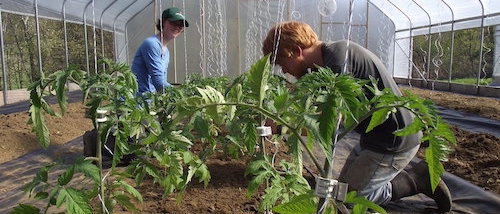“Did you remember to close the greenhouses?” was the panicked chorus on our flower farm, Moonshot Farm in East Windsor, New Jersey, every winter for years. Usually late at night, when we’re watching TV or even worse when we’re already in bed. One of us would sit up and realize we hadn’t closed up all of our tunnels. Leaving the farm was also challenging as we’d need to hire extra labor to open and close tunnels in our absence.
Last summer we finally automated our greenhouses with Orisha and can’t believe we didn’t do it sooner. By far, it’s the best change we’ve made to our farm in years. Orisha has sponsored the Growing for Market Podcast in the past; I actually first heard about their system on the GFM podcast, but this article is all my own thoughts and opinions. If you’ve been considering greenhouse automation, read on for a detailed overview of how we added Orisha to our farm.
Deciding on Orisha
Before we installed Orisha, our greenhouses were fully manual. Each greenhouse had roll-up sides which we opened and closed with a hand crank. Our heated greenhouses have propane heaters and electric vents/exhaust fans, all controlled by basic thermostats. We have eight tunnels spread across our farm, and for around six months of the year we need to open them most mornings and close them most nights. It took around 30 minutes to do this, twice a day (i.e., one hour a day) to walk around the farm to open/close the tunnels. Occasionally, we’d forget and plants would fry during a sunny day or freeze overnight.
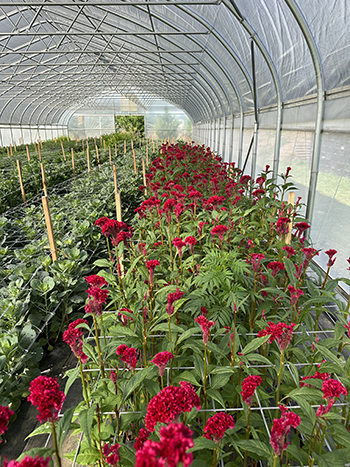
Orisha will partially open and close the greenhouses throughout the day based on conditions in the greenhouse in order to maintain the optimal climate for the crop as weather conditions change.
Identifying this as a major issue (and time suck) on our farm, we knew we wanted to automate. When we first began looking at greenhouse automation systems, we had some major sticker shock. A brand that was highly recommended by several peers was Advancing Alternatives. To add their controller, WiFi interface, various sensors, and sidewall motors would cost around $3,500 per greenhouse.
Because we primarily wanted automation to relieve us of the mental and physical labor of climate control, we didn’t see much point in automating one or two, but not all of our greenhouses. To go this route for all six of our heated houses would have been a $20,000 plus project. That figure was out of budget at the time. If you’re considering greenhouse automation and have some cash to invest in the project, I think Advancing Alternatives could be a good option and many farms seem to be using it with success.
On the other end of the cost spectrum, we considered a simple DIY approach. Sidewall motors could be added to each tunnel for a few hundred dollars. The motors could be programmed to timers to open every morning and close every evening. The issue we foresaw with this approach was that temperatures can vary widely from day to day based on sunlight conditions.
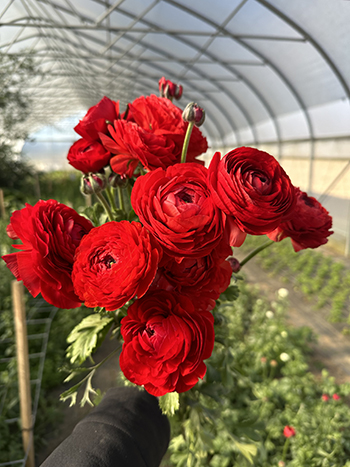
With humidity control, we’ve seen a dramatic drop in disease in our tunnels, including a reduction in powdery mildew on our ranunculus.
On cold gray winter days, we may not want to open the greenhouses at all. For an automated system, a timer approach seemed too manual, as we would still need to monitor conditions and override the timers as needed throughout the season.
Around this time, I first heard about Orisha on the GFM Podcast. Unlike a lot of the greenhouse automation systems out there — many designed for larger commercial greenhouse operations — Orisha seemed to be catered to small farms like mine that are using smaller high tunnel set-ups. Orisha boasted a tech-forward approach with a unique algorithm and the ability to control my greenhouse systems from anywhere. They offer a free consultation call to review your operation and determine if their system could be a good fit. After having the meeting, I was excited to give their system a try.
Orisha offers a unique pay-as-you-go pricing system; you essentially rent the equipment from them and pay a monthly fee. The pricing is based on how many components you have in each greenhouse, so will vary significantly depending on your operation. For our six heated greenhouses with roll-up sides, automated heating, and vents, we’re paying around $600/month. At $20/hour labor cost, it was costing us around that much to spend an hour opening and closing the greenhouses each day.
One nice thing about renting the equipment is that, if a component breaks, Orisha will replace it. When a sensor was acting up, they immediately replaced it, overnighting new parts and paying us to ship the faulty sensor back. Especially in a greenhouse environment where conditions are harsh on equipment, it’s nice insurance.
Installation
There was around a three-week lead time between ordering our equipment and receiving it, so our Orisha system arrived in late April, just around the time of our last frost. By late spring, we stop heating our greenhouses and left them open 24/7, so installing the greenhouse automation system became our lowest priority. If your farm is anything like ours, if it’s not on fire it’s probably not getting your attention in the spring.
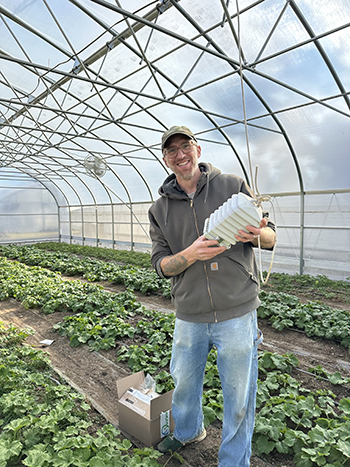
Each greenhouse has its own sensor for heat and humidity. Because the equipment is rented from Orisha, they have been fast to troubleshoot and replace any malfunctioning parts.
As a result, we ended up paying for the Orisha equipment for several months before we actually installed it. In retrospect, I’d probably recommend ordering the system in advance and requesting delivery a month or so before the heating season begins, allowing sufficient time for installation.
Orisha gives you the option to rent sidewall motors from them or purchase your own outright, and we went with the latter, finding some inexpensive motors on Amazon for under $100 each. For our roof vents, we purchased motors from Connecticut Greenhouse who does a lot of work with Orisha and was able to recommend the right motors that would be compatible with our vents.
Orisha’s system consists of several components. A central controller communicates with the greenhouses and connects them via WiFi to the Orisha software. Each greenhouse gets a sensor that tracks temperature and humidity.
Setting up Orisha is easy, but requires some basic electrical knowledge. Thankfully one of our staff members is a former electrical engineer, so it was pretty simple for him. Still, the first greenhouse took a couple of days to fully set up. Subsequent greenhouses went faster and faster, taking just a few hours to set up once we got the hang of it.
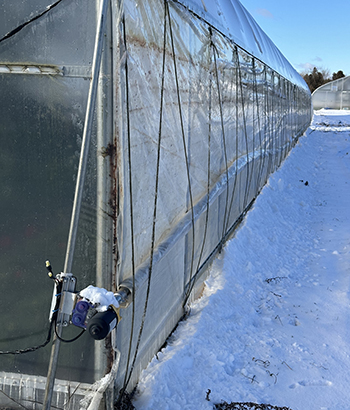
We used to spend over an hour each day opening and closing greenhouses across the farm. Now the Orisha sytem and motorized roll-up sides do the job. The fees for the automation system are almost exactly the same as our labor costs were for manually opening/closing.
We had some initial issues getting Orisha to work seamlessly. It turned out that our WiFi was to blame. While other devices have worked well on our field’s intermittent WiFi connections, we had issues getting Orisha to reliably connect. As a result, we couldn’t always access the system and had some intermittent issues with the programs we set up. We ended up running a new Ethernet cable from our router out to our field and installing an outdoor access point (made by TP-Link). Now that there is a strong, reliable internet connection in the field, the system works much better.
The Orisha system can function without WiFi, and will continue to work even during an internet outage. But I think farmers will have the best experience with the system if they can provide reliable internet access. Remote 4G/5G and even satellite internet could be an affordable solution for farmers with more remote greenhouses.
I’ll also add that Orisha does need electricity, but even an extension cord could work. We have a backup generator installed in case of a power outage, an important consideration especially during winter weather.
Programming Orisha
Orisha is controlled by an online interface that we have found to be extremely intuitive, user-friendly, and easy to navigate. A home screen displays all of our greenhouses and current conditions including temp and humidity. You can then click to view details for individual greenhouses.
Orisha enables you to set specific targets for both temperature and humidity and lets you choose different parameters based on time of day as well as sunlight levels. For example, you may choose to set lower temperatures on cloudy days to save fuel in heating costs. You can choose between an exact temperature or a range of temperatures. We aim for an 8°F to 10°F temperature range, at the advice of Orisha, as it allows the system to be more efficient.
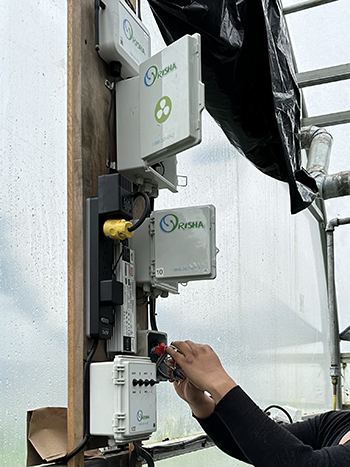
Setting up the Orisha system took some basic electrical knowledge but was relatively simple. All photos courtesy of the author.
Orisha offered a free training to teach us how to set up automation programs for each of our greenhouses. Now that we’re up to speed, it takes just a few minutes to update our settings based on crop needs.
Orisha’s customer service has been incredible throughout the setup process. They’ve answered most questions within a day (usually within a few hours) and spent a lot of time helping us troubleshoot various issues.
The magic of dehumidification
High humidity has always been our winter battle and it causes a number of diseases in flower crops, including botrytis and powdery mildew. Before installing Orisha, we would occasionally run heaters and vent the greenhouses simultaneously around dusk, to help burn off excess humidity. But this manual process was an extra chore and difficult to do regularly and effectively.
Orisha allows us to automate this dehumidification process and will run the heaters and vent automatically based on our settings. By cycling heaters on and off and only venting partially, it does this in a more energy-efficient way than we were able to do manually. Our reduction in humidity and disease has been dramatic. In past winters, humidity levels in our greenhouses often crept above 90 percent; now that we have the automatic dehumidification, we are often closer to 40 to 50 percent.
When we manually controlled our sidewalls, we usually only opened or closed them once a day. We either opened the walls all the way or kept them closed all day. Orisha enables a much more carefully controlled opening and closing. Sometimes the walls are cracked just a few inches or only the eastern walls are opened. It can quickly change settings throughout the day based on temperatures and cloud cover. The result is optimized airflow and low humidity. It’s a game changer for our winter crops. For the first time, we don’t have powdery mildew infesting our ranunculus.
Out of sight, out of mind
One warning is that, even with Orisha, farmers should still stay vigilant to issues and inspect their greenhouses daily. For us, the system has been working so well that it’s easy to trust that nothing is going wrong. However, we’ve had a few mechanical hiccups that the system didn’t alert us to.
In one instance, ice jammed our sidewall motors and caused the wires to get tangled into the sidewall. Orisha interpreted the sidewall as completely closed, when in fact it was open. We had a similar issue with a louvered vent getting jammed open.
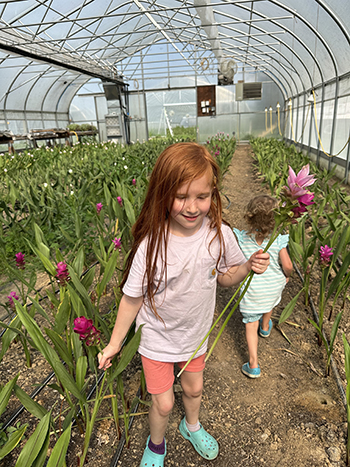
Installing Orisha has given us more time and mental energy back so we can focus on things that really matter, like spending time with our little kids.
Thankfully, Orisha has a reliable alerting system. We have it set to call our phones if temperatures or humidity are outside of the expected range. A nice feature is that it will continue to call us until the issue is resolved, which ensures the alert actually wakes us up in the middle of the night.
Resiliency is critical for us in winter, so we also have backup Govee thermometers in all of our greenhouses to provide alerts in case Orisha fails for whatever reason.
Limitations of Orisha
Overall we’ve been very satisfied with how Orisha is working for our greenhouses. Because their software and algorithms are relatively simple, we aren’t able to accomplish detailed customization. One example is with venting priorities. When it’s cold out, we can set the system to prioritize opening vents instead of opening the walls. However, this setting is based on 60°F outdoor temps. Because we heat most of our flower greenhouses minimally to around 40°F , it would be helpful to be able to adjust this setting to be a bit colder and open the greenhouses when it’s in the 50s outside.
It’s also worth noting that the Orisha system has been a bit difficult to integrate into our geothermal greenhouse, which uses geothermal heat pumps and a propane backup heater. The geothermal heat pumps have their own proprietary thermostat that can’t be controlled by Orisha, and we had some initial issues like the side walls opening when the geothermal heat was blasting.
We got around this by removing the propane backup heater from Orisha and having it controlled by a manual thermostat. We then set the sidewalls 10 degrees higher than the geothermal pumps, so that they wouldn’t open while the heater was on. A little clunky, but it works.
Peace of mind
Ultimately, the best part of Orisha hasn’t been the time and labor savings, or the dehumidification. Rather, it has been the peace of mind. Not just remembering to open/close greenhouses, but remembering to remember had been taking a huge toll. Our farmer brains are so often over-filled and burnt out that offloading the greenhouse controls to a computer has freed up so much mental space.
Looking to the future, we’re excited to try out Orisha’s irrigation controls someday. It seems like automating watering greenhouse crops would optimize plant health while taking even more off our mental plate.
For the first time in several years, we managed to take a vacation over Christmas and visit my family. While we were away, it was great to have Orisha on the team to manage the greenhouses in our absence.
Rebecca Kutzer-Rice owns Moonshot Farm, a specialty cut flower farm in East Windsor, NJ. She grows flowers year-round including in a geothermal greenhouse, for retail markets in and around NYC.
